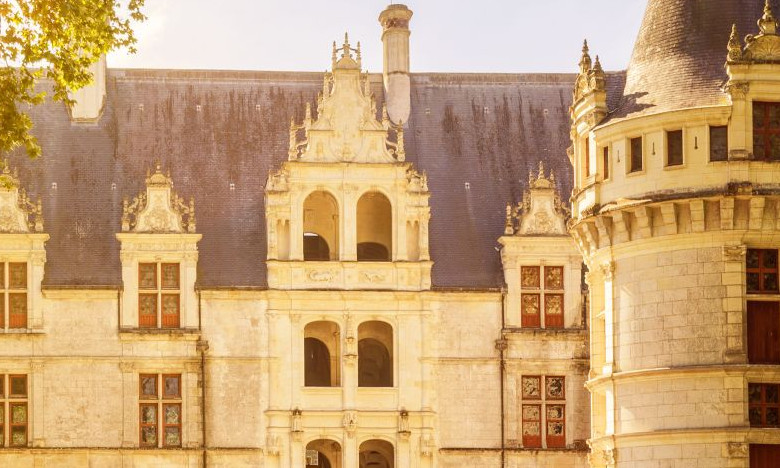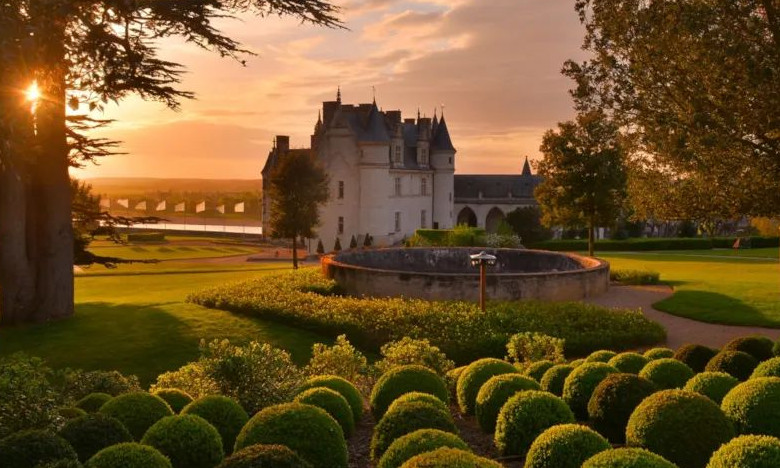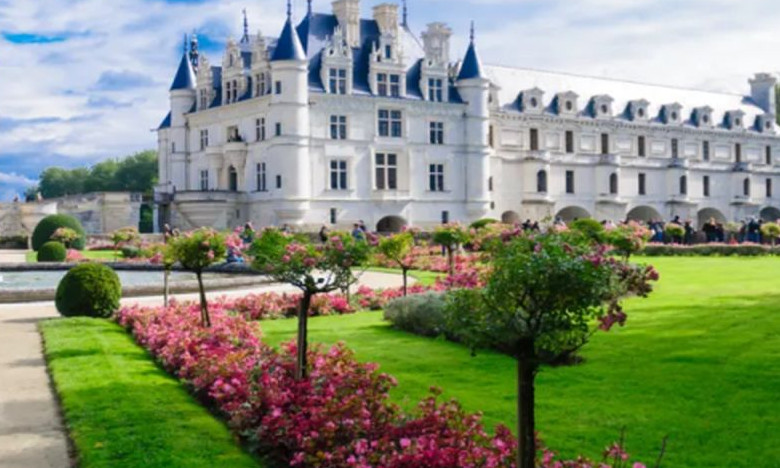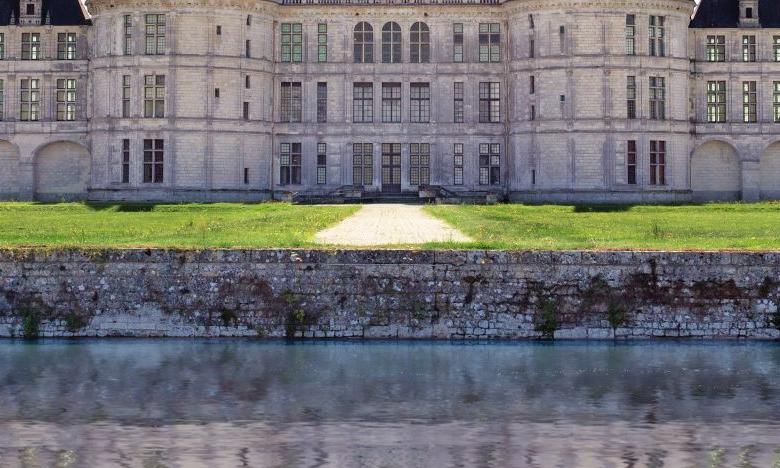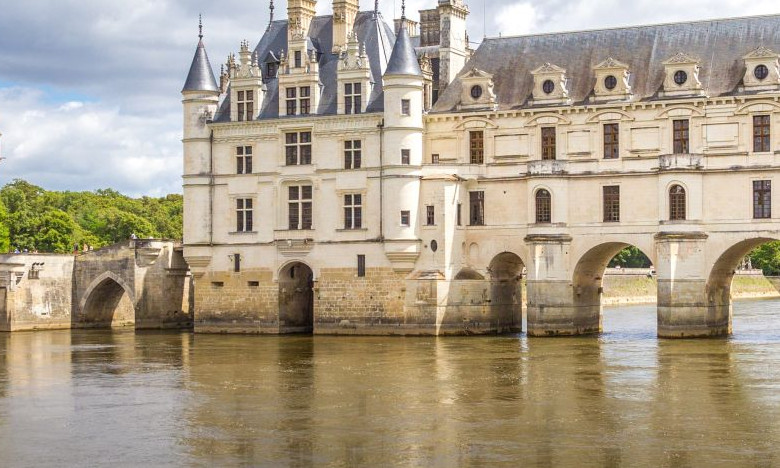The Loire Valley has long been famed as the perfect day trip from Paris and is an essential stop for any traveler wishing to experience some of the country’s most beautiful architecture and natural landscapes, not to mention superb wines. With more than 300 chateaux, with 21 of them qualifying as ‘Grands Sites’, the Loire Valley is the perfect place to visit if you want to see an abundance of castles in France. Don’t miss…
Le Château d’Amboise
Amboise is a charming historic town on the eastern borders of the Touraine province, which symbolises for many a “douceur de vivre” and the Garden of France. Its château formerly served as the seat of the Court of Kings Charles VIII and Francis I. Numerous academics and artists stayed at Amboise at the kings’ invitation, most notably Leonardo da Vinci, who arrived in 1516, died three years later and was buried in SaintHubert’s Chapel beside the château, according to his wishes. This small chateau is not as ornate as the other chateaux’s, but its structure with beautiful interiors, beautiful lush gardens and stunning views of the Loire River. The combination of styles Gothic and Renaissance makes this place a remarkable visit, in addition to its surrounding.
Le Château d'Angers
Another Ville d’Art et d’Histoire, Angers is perfect for strolling around, with a maze of little streets and old wooden houses with pitched roofs, as well as charming manor houses with tuffeau stone facades. Its medieval château looms above the river, ringed by moats, bolstered by 2.5m-thick walls and crowne with 17 enormous round towers. There are three unmissable sites in the town itself: the Saint-Martin Collegiate church, the Galerie David d’Angers and the Musée des Beaux-Arts. Plus, of course, the Saint-Maurice cathedral, a local treasure that’s well worth climbing the 103 steps to see.
Le Château d'Azay-le-Rideau
Perched on an island on the River Indre, romantic Azay-le-Rideau was built during the reign of Francis I by a rich financier, Gilles Berthelot, who wanted his fabulous new home to combine the latest technical innovations from Italy with the elegance of French architecture. The château has striking turrets, delicate stonework and perfectly proportioned windows, casting beautiful reflections on the surface of the surrounding water. Perhaps its most memorable feature is the open loggia staircase with its carved salamanders and ermines, coats of arms of Francis I and Queen Claude.
Le Château de Blois
Historically home to seven kings and 10 queens of France, the Royal Château de Blois gives visitors the best overview of all the history of the Loire châteaux. Its four wings, each of a different architectural style, bear witness to the evolution of French architecture over the centuries. On entering the courtyard you are greeted by a magnificent Renaissance stairway commissioned by Francis I, and as you wander through the royal apartments in the Francis I wing, historical events and settings emerge from the mists of time: the assassination of the Duke of Guise, the ‘Studiolo’ and its secret panels, Catherine de' Medici’s room and many others.
Le Château de Brissac
Brissac is France’s tallest château and the giant of the Loire Valley, with 204 sumptuously decorated rooms spread across seven floors. Highlights include the Grand Salon with family portraits of Duke of Brissac, the impressive dining table and the bedroom that King Louis XIII used during his visit in 1620. The château is also home to a 200-seat Belle-Époque theatre dedicated to opera, built at the end of the 19th century. In fine weather, stroll through the Anglo-Chinese garden and vineyard on the Brissac estate and, before leaving, meet in the château’s cellar to sample the local Rosé d’Anjou.
Le Château de Chambord
Arguably the Loire Valley’s most exceptional Renaissance masterpiece, this jaw-dropping château conceived by Francis I acts as a gateway to the whole area. The architect is unknown, but this particular project seems to have been inspired by sketches by the Italian master Leonardo da Vinci, particularly the famous double-helix staircase. The staircase ascends to terraces, from which you can enjoy an unobstructed view of the whole estate – which has the same footprint as Paris – across roofs, towers and chimneys. You can explore the estate on foot or by bike and enjoy the peace and quiet of nature in the 1,000 hectares of forest open to the public.
Le Château de Chenonceau
Another architectural masterpiece and royal residence, the Château de Chenonceau is a truly exceptional site by both design and history. It was managed and protected by women including Diane of Poitiers and Catherine de Medici, earning it the nickname of ‘Le Château des Dames’. The feminine touch is maintained today in beautiful flower arrangements in many of the rooms and, step by step, a guided tour of Chenonceau takes you through its history and its secrets. The château also boasts a collection of Masters’ paintings and an extraordinary set of Flemish tapestries. Outside, elegant gardens enhance the landscape – the Jardin Vert was designed by Bernard Palissy and the Italian maze is a fun distraction.The Orangerie is an on-site restaurant serving refined cuisine.
Le Château de Clos-Lucé
It was at Clos-Lucé, at the invitation of Francis I, that Leonardo da Vinci spent the last three years of his life, devoting his time to perfecting his inventions. Prolific and inspired, he worked as engineer, architect, even as entertainment coordinator, organising lavish festivities for the Court. At his residence just 300m from the château, he drew up plans for a model château for Francis I in Romorantin and designed the double-helix staircase for the Château de Chambord. Clos-Lucé is now a culture park where visitors can gain a better insight into the Italian master’s universe.


